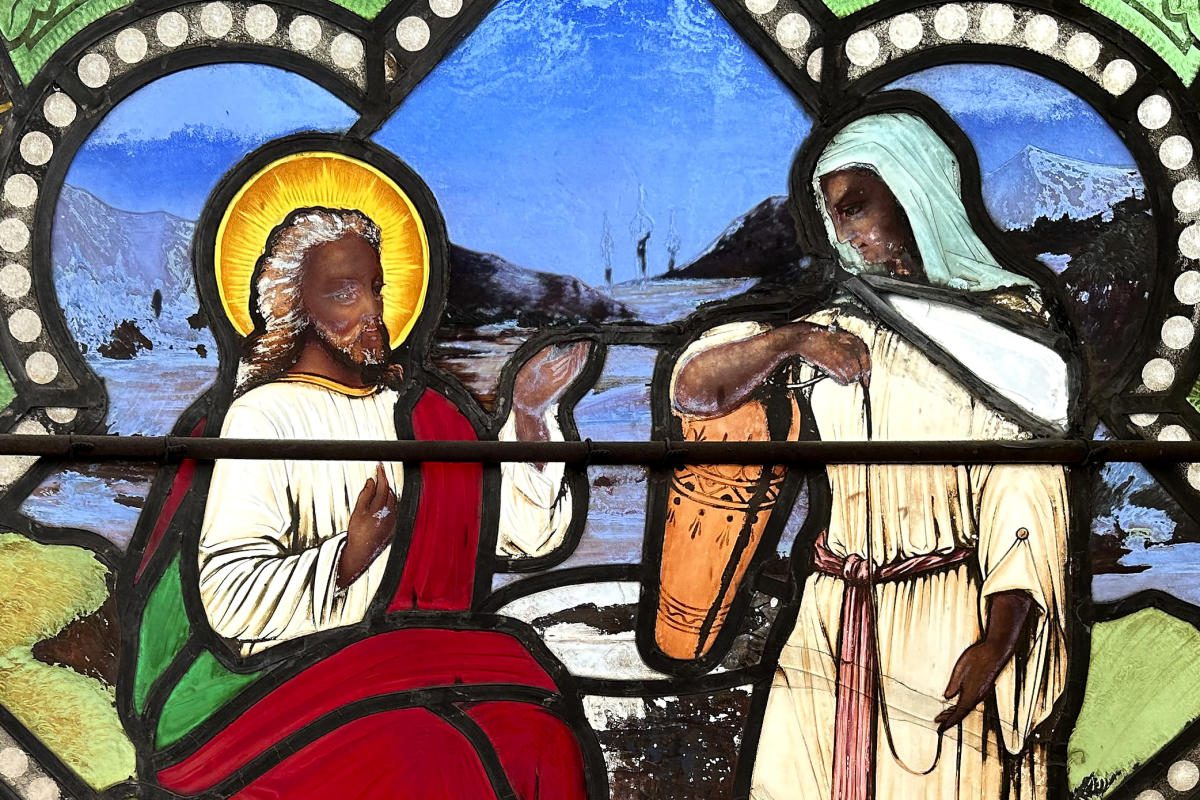Global Courant 2023-05-14 09:01:49
WARREN, RI (AP) — A nearly 150-year-old stained glass window from a church depicting a dark-skinned Jesus Christ interacting with women in New Testament scenes has raised questions about race, Rhode Island’s role in the slave trade and the place of women in 19th-century New England society.
The window installed in 1878 in the long-closed St. Mark’s Episcopal Church in Warren is the oldest known public example of stained glass depicting Christ as a person of color seen by an expert.
“This window is unique and highly unusual,” said Virginia Raguin, a humanities professor emeritus at the College of the Holy Cross in Worcester, Massachusetts, and an expert in the history of stained glass art. “I have never seen this iconography before that time.”
The 12-foot-high, 5-foot-wide (3.7 meters by 1.5 meters) window depicts two biblical passages in which women, also painted with dark skin, appear as equals to Christ. One shows Christ talking to Martha and Mary, the sisters of Lazarus, from the Gospel of Luke. The other shows Christ speaking to the Samaritan woman at the well from John’s Gospel.
The window made by Henry E. Sharp’s studio in New York was largely forgotten until a few years ago Hadley Arnold and her family purchased the 371-square-foot Greek Revival church building, which opened in 1830 and closed in 2010 to convert into their home.
When four stained glass windows were removed in 2020 to be replaced with clear glass, Arnold took a closer look. It was a cold winter’s day with the sunlight shining at just the right angle and she was amazed at what she saw in one of them: the human figures had dark skin.
“The skin tones were nothing like the white Christ you usually see,” says Arnold, who teaches architectural design in California after growing up in Rhode Island and earning a degree in art history from Harvard University.
The window has now come under scrutiny from scholars, historians and experts who are trying to determine the motivations of the artist, the church and the woman who commissioned the window in memory of her two aunts, both of whom married into families involved in the slave trade. trade.
Story continues
“Is this rejection? Is this a congratulation? Is this a secret sign?” said Arnold.
Raguin and other experts confirmed that the skin tones – in black and brown paint on milky white glass that was baked in a kiln to fix the image – were original and intentional. The piece shows some signs of aging, but is still in very good condition, she said.
But does it depict a black Jesus? Arnold is uncomfortable using that term, preferring to say it portrays Christ as a person of color, probably from the Middle East, which she thinks would make sense given where the Galilean Jewish minister came from.
Others think it is open to interpretation.
“For me, being of African American and Native American descent, I think it can represent both people,” said Linda A’Vant-Deishinni, the former executive director of the Rhode Island Black Heritage Society. She now directs the Roman Catholic Diocese of Providence’s St. Martin de Porres Center, which provides services to elderly residents.
“The first time I saw it, it just blew me away,” A’Vant-Deishinni said.
Victoria Johnson, a retired schoolteacher who became the first black woman to become a high school principal in Rhode Island, believes the figures in the glass are most definitely black.
“When I see it, I see black,” she said. “It was made at a time when in a white church up north, the only people of color they knew were black.”
Warren’s economy was based on building and outfitting ships, some of which were used in the slave trade, according to town history. And while there are records of enslaved people in the city before the Civil War, the racial makeup of St. Mark’s was probably mostly, if not entirely, white.
The window was commissioned by one Mary P. Carr in honor of two women, apparently her late aunts, whose names are on the glass, Arnold said. Mrs. H. Gibbs and Mrs. RB DeWolf were sisters and both married into families involved in the slave trade. The DeWolf family made a fortune as one of the country’s largest slave-trading families; Gibbs married a sea captain who worked for the DeWolfs.
Both women were listed as donors to the American Colonization Society, founded to support the migration of freed slaves to Liberia in Africa. The controversial effort was overwhelmingly rejected by black people in America, leading many former supporters to become abolitionists instead. DeWolf also left money in her will to start another church in accordance with egalitarian principles, according to the investigation.
Another clue is timing, Arnold said. The window was commissioned at a critical time in American history when supporters of Republican Rutherford B. Hayes and their South Democratic opponents agreed to settle the 1876 presidential election with what is known as the Compromise of 1877, which was essentially ended Reconstruction Era efforts to provide grants and protect the legal rights of formerly enslaved black people.
What was Carr trying to say about Gibbs and DeWolf’s ties to slavery?
“We don’t know, but it seems she honors people of conscience, however imperfect their actions or their effectiveness,” Arnold said. “I don’t think it would be any different.”
The window is also notable for showing Christ interacting with women as equals, Raguin said: “Both stories were selected to profile equality.”
For now, the window remains upright in a wooden frame where pews once stood. College classes have come to see it, and one recent spring afternoon was visited by a diverse group of eighth graders from The Nativity School in Worcester, a Jesuit boys’ school.
The boys learned about the history and importance of Raguin’s window.
“When I first brought this up in religion class, it was the first time the kids had ever heard of anything like that and they were genuinely curious about what all that was, why it mattered, why it existed,” religion said teacher Bryan Montenegro. “I thought it would be really valuable to come see it, be so close to it and really feel the diversity and inclusion that was so different for the time.”
Arnold hopes to find a museum, college, or other institution that can preserve and display the window for academic study and public appreciation.
“I think this belongs in the public trust,” she said. “I don’t believe it was ever intended to be a private property.”








